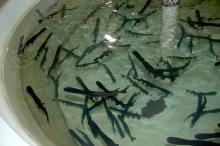Information Possibly Outdated
The information presented on this page was originally released on August 30, 2012. It may not be outdated, but please search our site for more current information. If you plan to quote or reference this information in a publication, please check with the Extension specialist or author before proceeding.
MSU research reels in success for fisheries
By Laci Kyles
MSU Forest and Wildlife Research Center
MISSISSIPPI STATE – Mississippi has some of the best fisheries in the nation, and Mississippi State University researchers are working to keep the threatened species in them from disappearing.
Peter Allen, assistant professor of aquatic sciences, conducts research on the fisheries that provide food and fun for Mississippians. He works at MSU’s South Farm Aquaculture Facility, a joint venture of the Forest and Wildlife Research Center and the Mississippi Agricultural and Forestry Experiment Station.
Allen is an expert in how fish adapt to environmental changes. His work includes projects on paddlefish, alligator gar, catfish and other species. With 204 native fish species, only four other states rank higher than Mississippi in types of freshwater fish.
“The paddlefish is a native species with a lot of potential in Mississippi,” Allen said. “This species is a boneless fish and produces tasty caviar.”
The paddlefish has a long, spatula-shaped snout that is longer than the rest of its head. Human constructions such as dams, water control structures and water diversions have caused paddlefish populations to decline.
Paddlefish are sensitive to changes in water quality, Allen said. MSU researchers are examining how much oxygen paddlefish need and how the fish adapt to low oxygen levels. The scientists hope to use the information to develop management suggestions for Mississippi fisheries operators.
Like paddlefish, the alligator gar is sensitive to changes in water quality, and population numbers are decreasing. A dual row of large teeth in the upper jaw and an elongated snout give this fish its alligator-like appearance. The alligator gar is one of the largest freshwater fish found in North America.
“We are trying to get a better understanding of the alligator gar’s early life history,” Allen said. “This research is needed to provide long-term management strategies for the remaining populations in Mississippi and to guide reintroduction efforts in Mississippi and elsewhere.”
Allen and others are researching how channel and hybrid catfish react to high temperatures and climate change.
“We are trying to understand how increasing temperatures may affect different strains of catfish and what genes contribute to the health of these fish at high temperatures,” Allen said.
Determining the best type of catfish to produce in Mississippi’s climate will assist catfish production, a $222 million industry in the state.
One of the newest fish to be studied is the killifish, an important baitfish on Mississippi’s coast. MSU is the only university in the state examining the potential for inland saltwater fish production facilities.
“The Gulf of Mexico oil spill and extensive harvest have diminished the populations of these fish,” said Bruce Leopold, head of MSU’s Department of Wildlife, Fisheries and Aquaculture. “This research could provide opportunities for existing aquaculture facilities to enhance their production.”
The research at Mississippi State University is vital to protecting the state’s resources, Leopold added.
“Understanding these fish species allows us to protect and enhance their populations and maintain the recreation opportunities and sustenance they provide,” Allen said.





